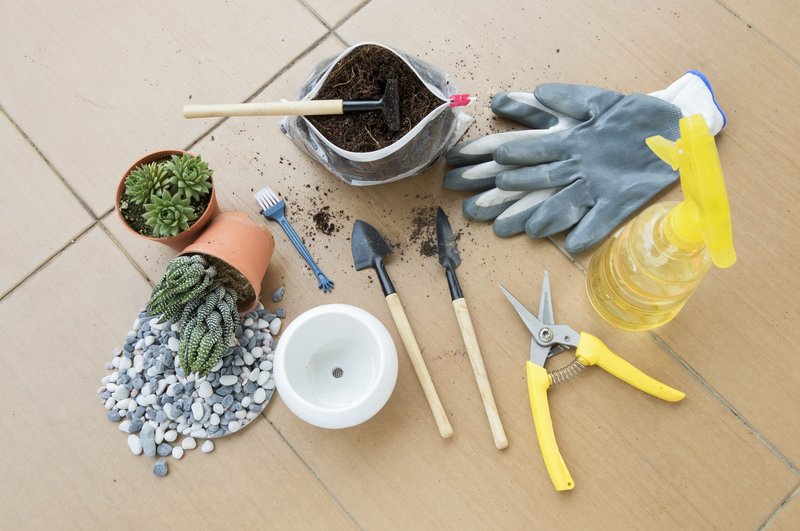Shielding Your Garden Plants from Winter's Chill
Posted on 31/05/2025
Shielding Your Garden Plants from Winter's Chill: The Ultimate Guide
As the temperature drops and the days become shorter, gardeners everywhere face the annual challenge of protecting their beloved plants from the harsh realities of winter's chill. Whether you're nurturing hardy perennials, delicate annuals, or vegetable patches, understanding how to shield your garden plants from cold weather can make the difference between vibrant spring growth and disappointing loss. In this comprehensive guide, you'll discover effective, time-tested methods for winter plant protection, ensuring your garden thrives even after the frostiest days.
Understanding the Threats: How Winter's Chill Impacts Garden Plants
Winter is a season of contrasts--beautiful, but potentially devastating for unprepared gardens. Before diving into specific protection methods, it's vital to understand the various ways in which cold weather affects plants:
- Frost Damage: When temperatures drop quickly, ice crystals can form within plant tissues, rupturing cell walls and causing lasting damage.
- Desiccation (Winter Drying): Cold winds and frozen ground can rob plants of essential moisture, leading to dehydration.
- Root Freezing: Exposed root systems of container or shallow-rooted plants may freeze and die if not properly insulated.
- Sunscald: In late winter, intense sun can warm bark during the day, only to have it freeze rapidly at night, resulting in cracked and damaged bark.
- Pest and Disease Vulnerability: While some pests die off in cold, others like voles or rabbits can damage bark and roots, while fungi might thrive in damp winter conditions.
Recognizing these threats is the first step to effectively shielding your garden plants from winter's chill. Let's explore the best strategies to protect your green oasis!

Preparing the Garden: Essential Steps Before the Freeze
Preparation is paramount when it comes to safeguarding your garden. The following pre-winter tips will help your plants weather the cold:
- Clean Up Debris: Remove fallen leaves, dead stems, and spent annuals to reduce hiding places for pests and disease spores.
- Mulch Liberally: Apply a 2-4 inch layer of organic mulch (like shredded leaves, wood chips, or straw) around perennials and trees to lock in soil warmth and moisture.
- Water Deeply: Give your garden a deep watering before the ground freezes. Moist soil retains heat better and prevents dehydration.
- Move Container Plants: Relocate pots and planters to sheltered spots such as garages, sheds, or close to house walls to capitalize on radiant heat.
- Prune Strategically: Avoid heavy pruning in late autumn, as it may encourage new growth that's vulnerable to frost.
- Protect Young & Delicate Plants: Mark young or special specimens for extra attention as winter approaches.
Pro Tip: Mulching is one of the simplest and most effective tools for shielding garden plants from winter temperature fluctuations. Don't skimp on this crucial step!
Insulating Techniques: How to Effectively Keep Plants Warm
Insulation is the key to shielding garden plants from winter cold. The following methods are proven to create protective barriers between your plants and the worst of winter's chill:
1. Mulching - Nature's Blanket
- Best for: Perennials, roots, bulbs, and young trees.
- How-to: Once the ground has cooled but before it freezes solid, apply a thick (2-4 inches) layer of organic mulch around the base of plants and over garden beds. This maintains even soil temperatures and reduces freeze/thaw cycles.
- Tip: Remove some mulch in early spring to prevent rot and encourage growth.
2. Row Covers and Frost Cloths
- Best for: Vegetable gardens, annuals, and sensitive perennials.
- How-to: Use breathable fabrics like horticultural fleece, frost cloth, or even old bed sheets. Secure them loosely over crops and anchor with stones or soil. These covers trap heat while allowing moisture and light through.
- Tip: Avoid plastic, which can cause overheating or retain too much moisture.
3. Cloches and Cold Frames
- Best for: Individual plants, seedlings, herbs, or short crops.
- How-to: Place glass or plastic domes (cloches) over vulnerable plants, or build a simple cold frame from old windows and wood to act as a mini greenhouse.
- Tip: Vent on warm days to prevent overheating and condensation.
4. Burlap Wraps and Screens
- Best for: Evergreens, new shrubs, small trees, and roses.
- How-to: Wrap sensitive shrubs with burlap, or use wooden stakes and burlap screens to shield from wind. This reduces windburn and limits moisture loss.
- Tip: Avoid wrapping too tightly to allow some airflow and prevent disease.
5. Protecting Roots of Container Plants
- Move pots: Cluster containers together and place them against a south- or west-facing wall for extra warmth.
- Insulate pots: Use bubble wrap, old blankets, or horticultural fleece around pots, or sink containers into the soil to shield roots from freezing temps.
- Elevate: Ensure pots are off cold concrete to reduce direct exposure to freezing surfaces.
Wind and Moisture Control: Guarding Against Desiccation and Windburn
Winter winds can be as damaging as the cold itself. Wind strips moisture from plant tissues, causing browning and dieback--especially in evergreens and exposed shrubs. Here's how to shield garden plants from winter's drying winds:
- Windbreaks: Erect temporary fencing or plant rows of evergreens (like juniper or pine) to block prevailing winds.
- Burlap Screens: Surround particularly vulnerable shrubs and evergreens with burlap barriers spaced a few inches from branches.
- Anti-Desiccant Sprays: Apply horticultural wax sprays to leaves of evergreens to reduce water loss; follow manufacturer directions for safety.
- Water Well: Continue watering on mild days until the ground freezes so that plants start winter hydrated.
Specialized Care for Vulnerable Plants
Some plants need extra TLC when shielding from winter cold:
1. Roses
- Prune lightly: Remove dead or weak stems in late autumn.
- Mound mulch: Heap soil or mulch about 8-12 inches up the base to protect grafts.
- Wrap: Northern gardeners often wrap canes loosely with burlap to limit wind exposure.
2. Fruit Trees & Young Trees
- Trunk guards: Spiral plastic tree guards or wrap with burlap to prevent sunscald and rodent damage.
- Mulch ring: Maintain a mulch ring around, but not touching, trunks to insulate shallow roots.
3. Herbaceous Perennials
- Leave top growth: Keeping dead stems and foliage can shield crowns from the cold.
- Divide carefully: Only divide plants in early fall or spring, not late autumn.
Dealing with Ice and Snow
Snow acts as a natural insulator, protecting garden beds from temperature fluctuations. However, heavy ice or snow can damage branches and flatten plants:
- Shake it off: After heavy snowfall, gently brush snow off evergreens and shrubs using a broom to prevent breakage.
- Avoid salt: Use sand, kitty litter, or sawdust for icy paths near plants to avoid salt damage.
- Support branches: Tie columnar evergreens with soft twine to prevent splaying under snow weight.
Indoor Rescue: Bringing Tender Plants Inside
For truly tropical or cold-sensitive garden plants (like citrus, geraniums, or some succulents), the best way of shielding winter garden plants is sometimes to overwinter them indoors:
- Inspect for pests: Clean leaves and check roots before bringing pots indoors.
- Give adequate light: Place plants near south-facing windows, or use grow lights if needed.
- Reduce watering: Many plants require less water in cooler, less sunny winter homes.
- Humidity: Dry indoor air can stress plants; mist leaves or use a tray of pebbles and water for humidity.
Common Mistakes to Avoid When Protecting Garden Plants from Winter Chill
- Late preparations: Wait until after the first hard frost, not after prolonged freezes, to mulch and insulate.
- Using plastic sheeting: Plastic traps moisture, causes overheating, and can do more harm than good.
- Ignoring containers: Container plants freeze faster than in-ground plants; treat them with extra care.
- Pruning at the wrong time: Late-fall pruning often prompts new growth vulnerable to frost damage.
- Neglecting water: Dry plants succumb more easily to cold weather stress.
Spring Recovery: Helping Plants Bounce Back
Once the worst of winter's chill is over, you'll want to ensure your plants make a strong recovery:
- Remove protection gradually: Don't rush to take off all mulches, covers, or wraps at once--instead, do so gradually as temperatures stabilize.
- Prune away winter damage: Only prune dead or broken branches after new growth starts, so you avoid cutting living tissue.
- Feed gently: Use balanced, slow-release fertilizer or compost to support new shoots and root growth.
- Monitor for pests: Check emerging plants for insects or fungus, as stressed plants are more vulnerable.

Frequently Asked Questions about Shielding Garden Plants from Winter's Chill
1. When should I start protecting my garden plants for winter?
Begin preparations in late autumn, just before the first hard frost. This timing ensures you protect root systems and young growth without trapping warm-loving pests in the mulch.
2. What is the best mulch for winter plant protection?
Organic mulches such as shredded leaves, straw, pine needles, or wood chips are best for insulating soil and roots. Avoid using dense or sodden materials that could encourage rot.
3. How can I protect my potted plants from winter cold?
Move pots to sheltered spots, wrap with insulating materials, and group together for added protection. For severe climates, consider bringing valuable specimens indoors or into a cold frame.
4. Is it better to prune plants before or after winter?
Light pruning is okay before winter, but wait until spring to remove major limbs or damage. This helps plants avoid new growth that's vulnerable to cold snaps.
Conclusion: Keep Your Garden Thriving through Winter's Chill
Shielding your garden plants from winter's chill doesn't have to be complicated, but it does require a thoughtful, proactive approach. By combining proper pre-winter preparation with effective insulation techniques, wind protection, and a bit of plant-specific care, you'll maximize your garden's survival and beauty--no matter how harsh the weather outside.
Winter may be inevitable, but damage to your garden is not. With attention to detail and the right strategies, your garden will emerge healthy and lush come spring--rewarding your effort with vigorous growth, blooms, and bounty.

